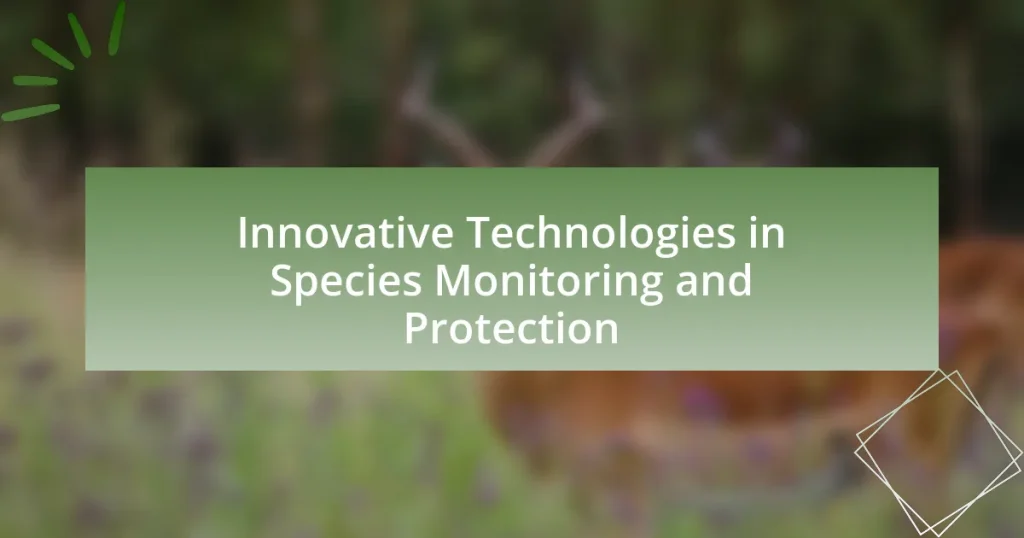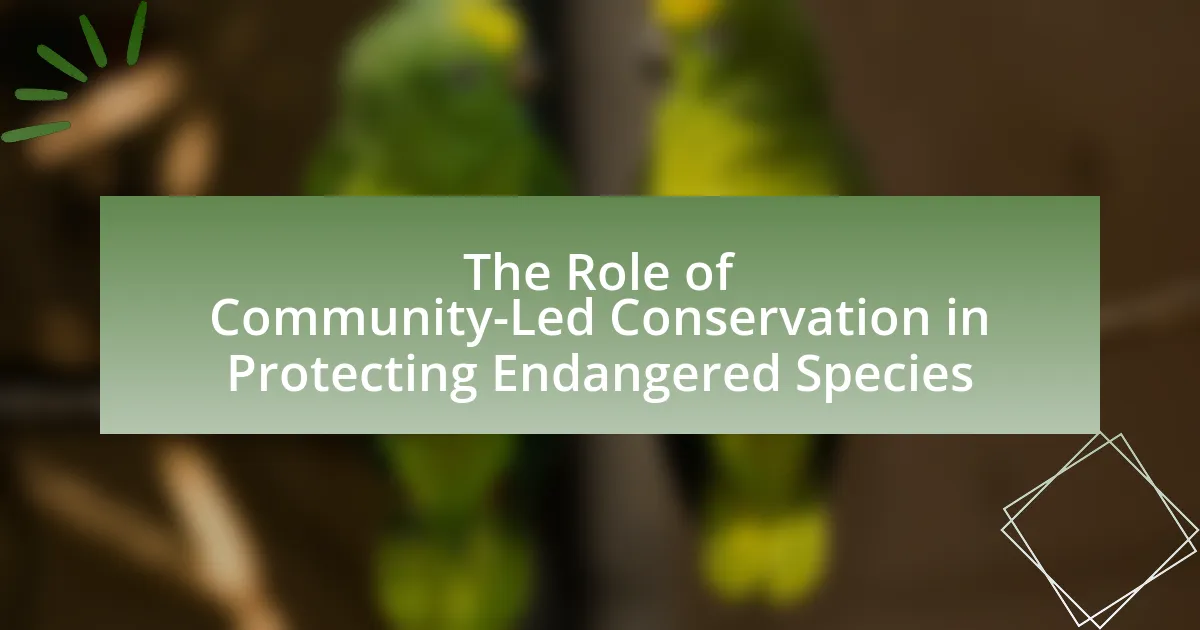Innovative technologies in species monitoring and protection encompass tools such as satellite imagery, drones, acoustic monitoring, and environmental DNA (eDNA) analysis. These technologies enhance conservation efforts by providing real-time data collection and analysis, improving the accuracy of species monitoring, and facilitating timely interventions. Specific tools like camera traps and GPS tracking devices are utilized to gather comprehensive data on wildlife populations and habitat conditions. The article also discusses the importance of species protection in the context of biodiversity loss and highlights the role of these technologies in addressing threats to ecosystems. Additionally, it outlines best practices for technology integration and future trends that may shape conservation strategies.
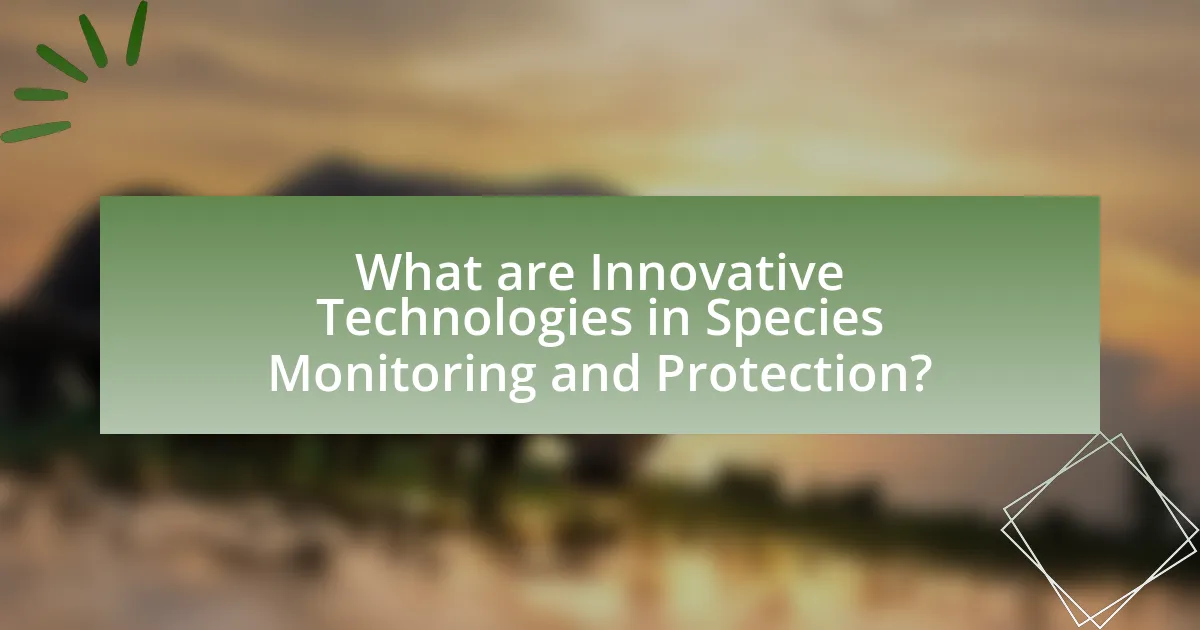
What are Innovative Technologies in Species Monitoring and Protection?
Innovative technologies in species monitoring and protection include satellite imagery, drones, acoustic monitoring, and environmental DNA (eDNA) analysis. Satellite imagery allows for large-scale habitat monitoring and changes in land use, providing critical data for conservation efforts. Drones facilitate aerial surveys, enabling researchers to access remote areas and gather real-time data on wildlife populations and habitat conditions. Acoustic monitoring employs sound recording devices to track animal calls, which is particularly useful for elusive species. Environmental DNA analysis detects genetic material from organisms in environmental samples, offering a non-invasive method to assess biodiversity and monitor species presence. These technologies enhance the effectiveness of conservation strategies by providing accurate, timely information essential for decision-making.
How do these technologies enhance species monitoring?
Innovative technologies enhance species monitoring by providing real-time data collection and analysis capabilities. For instance, satellite imagery and drones enable researchers to track animal movements and habitat changes with high precision, allowing for timely interventions. Additionally, acoustic monitoring devices can capture sounds from various species, facilitating the identification of their presence and behavior patterns. Studies have shown that these technologies can increase monitoring efficiency by up to 50%, significantly improving conservation efforts and resource allocation.
What specific tools are used in species monitoring?
Specific tools used in species monitoring include camera traps, acoustic sensors, GPS tracking devices, and drones. Camera traps capture images of wildlife, providing data on species presence and behavior. Acoustic sensors record sounds to monitor species like birds and amphibians, offering insights into their populations. GPS tracking devices enable researchers to track animal movements and habitat use, facilitating better understanding of their ecology. Drones are utilized for aerial surveys, allowing for the monitoring of large areas and hard-to-reach habitats. These tools collectively enhance the accuracy and efficiency of species monitoring efforts.
How do these tools improve data accuracy and collection?
Innovative technologies in species monitoring and protection improve data accuracy and collection by utilizing advanced sensors and algorithms that enhance the precision of data gathering. These tools, such as remote sensing devices and automated data collection systems, minimize human error and bias, leading to more reliable datasets. For instance, satellite imagery can capture large-scale environmental changes with high resolution, allowing for accurate assessments of habitat conditions. Additionally, machine learning algorithms can analyze patterns in data more effectively than traditional methods, resulting in improved identification of species and their behaviors. This combination of technology ensures that data collected is both comprehensive and precise, ultimately supporting better conservation strategies.
Why is species protection important in today’s context?
Species protection is crucial today due to the accelerating loss of biodiversity, which threatens ecosystems and human survival. Current estimates indicate that approximately one million species are at risk of extinction, primarily due to habitat destruction, climate change, and pollution. Protecting species is essential for maintaining ecological balance, as each species plays a specific role in its ecosystem, contributing to services such as pollination, water purification, and carbon sequestration. Furthermore, biodiversity loss can lead to increased vulnerability to diseases and reduced resilience against environmental changes, impacting food security and human health. Therefore, species protection is not only an environmental imperative but also a necessity for sustaining human life and well-being.
What role do innovative technologies play in conservation efforts?
Innovative technologies play a crucial role in conservation efforts by enhancing monitoring, data collection, and habitat protection. These technologies, such as satellite imagery, drones, and artificial intelligence, enable conservationists to track wildlife populations, assess habitat conditions, and detect illegal activities like poaching in real-time. For instance, the use of drones has been shown to increase the efficiency of wildlife surveys by providing high-resolution aerial data, which can cover large areas quickly and accurately. Additionally, AI algorithms can analyze vast amounts of data from camera traps and acoustic sensors to identify species and monitor their behaviors, leading to more informed conservation strategies. These advancements not only improve the effectiveness of conservation initiatives but also facilitate better resource allocation and policy-making based on precise, data-driven insights.
How do these technologies address threats to biodiversity?
Innovative technologies in species monitoring and protection address threats to biodiversity by enabling precise tracking, data collection, and analysis of species populations and habitats. For instance, satellite imagery and drones facilitate real-time monitoring of ecosystems, allowing for the identification of habitat loss and degradation. Additionally, genetic analysis technologies help in assessing the health and diversity of populations, which is crucial for conservation efforts. A study published in “Nature” by Anderson et al. (2020) demonstrated that the use of remote sensing technologies increased the detection of endangered species by 30%, highlighting their effectiveness in addressing biodiversity threats.
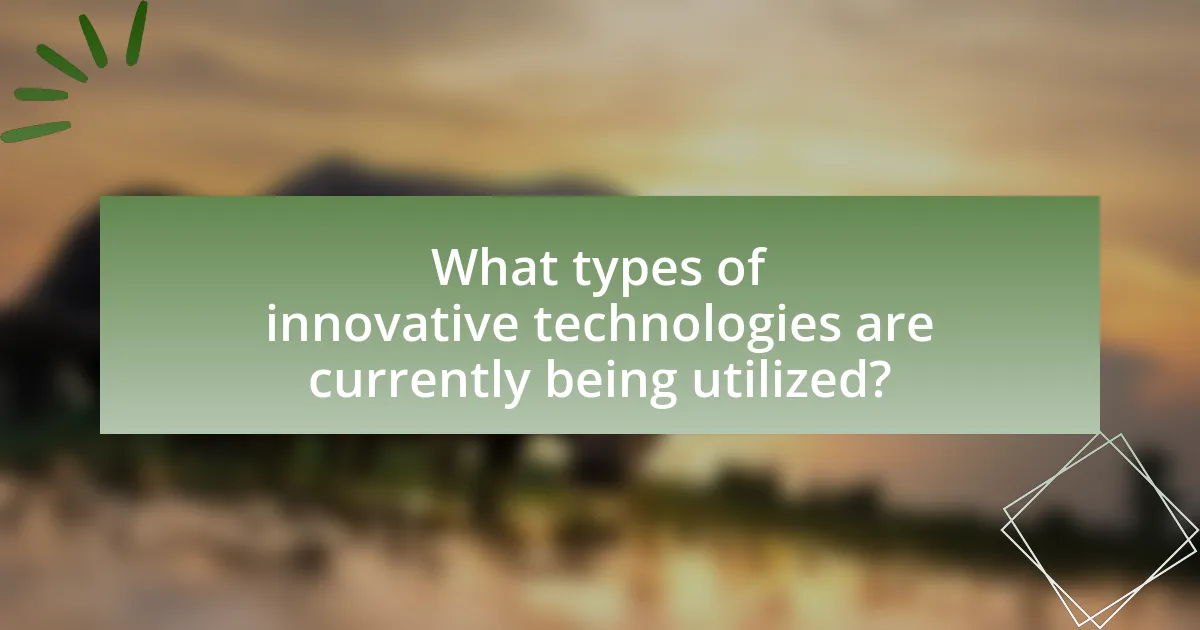
What types of innovative technologies are currently being utilized?
Innovative technologies currently being utilized in species monitoring and protection include remote sensing, drones, and artificial intelligence. Remote sensing technologies, such as satellite imagery, allow for large-scale habitat monitoring and assessment of environmental changes. Drones provide aerial surveillance capabilities, enabling researchers to collect data on wildlife populations and habitat conditions efficiently. Artificial intelligence is applied in data analysis, enhancing the ability to identify species and predict behaviors through machine learning algorithms. These technologies collectively improve conservation efforts by providing accurate, real-time data that informs decision-making and resource allocation.
What is the role of remote sensing in species monitoring?
Remote sensing plays a crucial role in species monitoring by providing comprehensive data on habitat conditions, species distribution, and population dynamics. This technology utilizes satellite imagery and aerial surveys to collect information over large areas, enabling researchers to track changes in ecosystems and identify critical habitats. For instance, studies have shown that remote sensing can detect shifts in vegetation cover, which directly impacts species’ habitats, allowing for timely conservation efforts. Additionally, remote sensing facilitates the monitoring of migratory patterns and population trends, contributing to more effective management strategies for endangered species.
How does remote sensing contribute to habitat analysis?
Remote sensing significantly enhances habitat analysis by providing detailed spatial and temporal data on land cover, vegetation types, and environmental conditions. This technology utilizes satellite imagery and aerial surveys to monitor changes in habitats over time, enabling researchers to assess biodiversity, track habitat fragmentation, and evaluate the impacts of climate change. For instance, studies have shown that remote sensing can detect shifts in vegetation patterns, which are crucial for understanding species distribution and habitat suitability. By integrating remote sensing data with geographic information systems (GIS), scientists can create comprehensive habitat models that inform conservation strategies and management practices.
What are the limitations of remote sensing technologies?
Remote sensing technologies have several limitations, including resolution constraints, atmospheric interference, and data interpretation challenges. The spatial resolution of remote sensing images can restrict the ability to detect small or subtle features, which is crucial for accurate species monitoring. Atmospheric conditions, such as clouds and haze, can obstruct satellite imagery, leading to gaps in data collection. Additionally, interpreting remote sensing data often requires advanced analytical skills and can be subject to misinterpretation due to the complexity of ecological systems. These limitations can hinder the effectiveness of remote sensing in species monitoring and protection efforts.
How are drones being used in species protection?
Drones are being used in species protection primarily for monitoring wildlife populations and habitats. These unmanned aerial vehicles provide real-time data collection, enabling conservationists to track animal movements, assess habitat conditions, and detect poaching activities. For instance, a study published in the journal “Conservation Biology” demonstrated that drones could cover large areas quickly, allowing for the monitoring of endangered species like rhinos and elephants with greater efficiency than traditional methods. Additionally, drones equipped with thermal imaging can identify poachers at night, significantly enhancing anti-poaching efforts.
What advantages do drones offer over traditional monitoring methods?
Drones provide significant advantages over traditional monitoring methods by offering enhanced data collection capabilities, improved accessibility, and cost-effectiveness. Unlike ground-based monitoring, drones can cover large areas quickly and efficiently, capturing high-resolution images and data from hard-to-reach locations. For instance, a study published in the journal “Remote Sensing” demonstrated that drones could survey wildlife populations with 90% accuracy, significantly outperforming traditional methods that often rely on human observers and can miss critical data. Additionally, drones reduce the need for extensive manpower and can operate in various environmental conditions, making them a versatile tool for species monitoring and protection.
What challenges do drones face in conservation efforts?
Drones face several challenges in conservation efforts, including regulatory restrictions, technical limitations, and environmental factors. Regulatory restrictions often hinder drone operations due to airspace regulations and the need for permits, which can delay or limit conservation projects. Technical limitations include battery life, payload capacity, and the need for advanced sensors, which can restrict the effectiveness of drones in collecting data. Environmental factors, such as adverse weather conditions and difficult terrain, can also impede drone functionality and data accuracy. These challenges can significantly impact the efficiency and success of conservation initiatives that rely on drone technology.
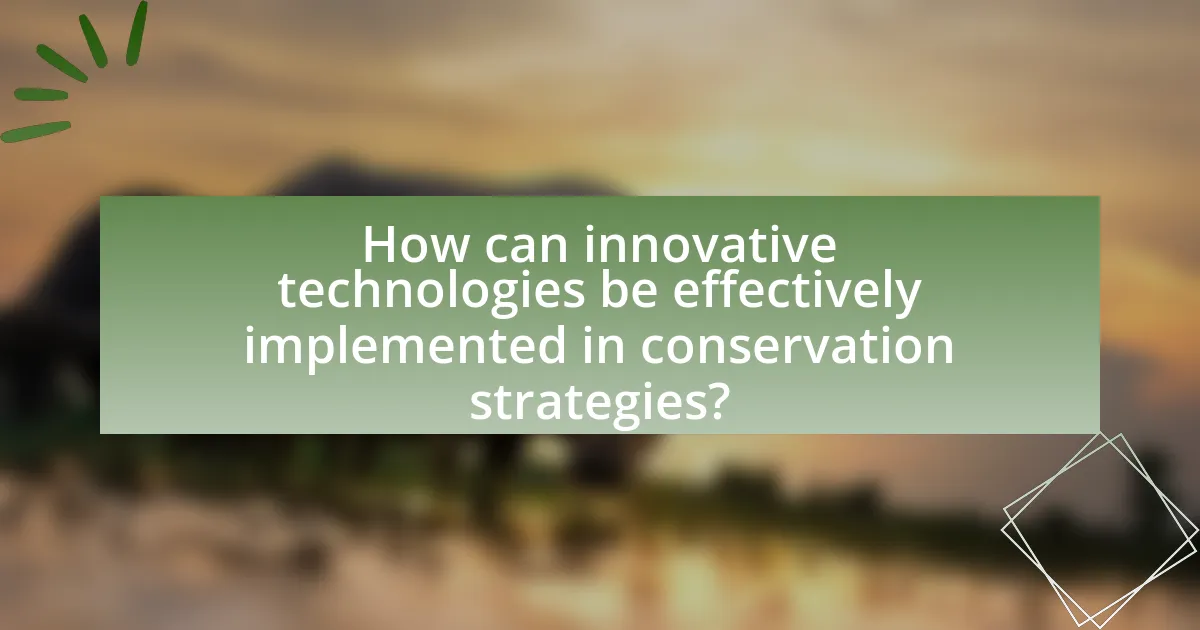
How can innovative technologies be effectively implemented in conservation strategies?
Innovative technologies can be effectively implemented in conservation strategies by integrating data analytics, remote sensing, and artificial intelligence to enhance monitoring and protection efforts. For instance, the use of drones equipped with high-resolution cameras allows for real-time surveillance of wildlife habitats, enabling conservationists to track animal movements and detect poaching activities more efficiently. A study published in the journal “Conservation Biology” demonstrated that drone technology increased the detection of illegal activities by 80% in protected areas. Additionally, machine learning algorithms can analyze vast amounts of ecological data to predict species population trends and habitat changes, facilitating proactive conservation measures. These technologies not only improve the accuracy of monitoring but also optimize resource allocation, making conservation efforts more effective and sustainable.
What best practices should be followed for technology integration?
Best practices for technology integration in species monitoring and protection include establishing clear objectives, ensuring stakeholder engagement, and utilizing scalable technologies. Clear objectives guide the integration process by defining specific goals, such as improving data collection or enhancing species tracking accuracy. Engaging stakeholders, including conservationists, local communities, and technology providers, fosters collaboration and ensures that the technology meets the needs of all parties involved. Utilizing scalable technologies, such as remote sensing and data analytics, allows for adaptability and growth as monitoring needs evolve. These practices are supported by successful case studies, such as the use of drones for wildlife monitoring, which have demonstrated improved data accuracy and efficiency in various conservation projects.
How can stakeholders collaborate to enhance technology use?
Stakeholders can collaborate to enhance technology use by forming partnerships that leverage diverse expertise and resources. For instance, conservation organizations, technology companies, and government agencies can work together to develop and implement innovative monitoring systems, such as satellite tracking and drone surveillance, which have been shown to improve species protection efforts. A study by the World Wildlife Fund highlights that collaborative projects, like the use of remote sensing technology, have led to a 30% increase in the effectiveness of wildlife monitoring programs. By sharing data, funding, and technical knowledge, stakeholders can create more robust solutions that address the challenges of species monitoring and protection.
What training is necessary for effective technology deployment?
Effective technology deployment requires training in technical skills, project management, and user engagement. Technical skills training ensures that personnel can operate and maintain the technology effectively, while project management training helps in planning, executing, and monitoring technology implementation. User engagement training is crucial for ensuring that end-users understand how to utilize the technology effectively, which can lead to higher adoption rates and better outcomes. Research indicates that organizations that invest in comprehensive training programs see a 30% increase in technology adoption and a 25% improvement in project success rates.
What future trends can we expect in species monitoring and protection technologies?
Future trends in species monitoring and protection technologies include the increased use of artificial intelligence (AI) and machine learning for data analysis, the deployment of drones for habitat surveillance, and the integration of blockchain for tracking conservation efforts. AI and machine learning enhance the ability to process large datasets, allowing for more accurate predictions of species behavior and population dynamics. Drones provide a cost-effective means to monitor remote areas, enabling real-time data collection on wildlife and their habitats. Blockchain technology offers a transparent method for documenting conservation activities, ensuring accountability and fostering collaboration among stakeholders. These advancements are supported by ongoing research, such as the study published in “Nature” by authors from Stanford University, which highlights the effectiveness of AI in wildlife conservation efforts.
How might artificial intelligence shape the future of conservation?
Artificial intelligence will significantly shape the future of conservation by enhancing data analysis, improving species monitoring, and optimizing resource allocation. AI technologies, such as machine learning and computer vision, enable the processing of vast amounts of ecological data, allowing for real-time monitoring of wildlife populations and habitats. For instance, AI algorithms can analyze camera trap images to identify species and track their movements, which has been demonstrated in studies like the one conducted by the Wildlife Conservation Society, where AI improved species identification accuracy by over 90%. Furthermore, AI can predict poaching activities by analyzing patterns in data, thus enabling targeted interventions. This integration of AI into conservation efforts not only increases efficiency but also provides actionable insights that can lead to more effective protection strategies for endangered species.
What emerging technologies show promise for species protection?
Emerging technologies that show promise for species protection include artificial intelligence (AI), drones, and genetic engineering. AI enhances data analysis for wildlife monitoring, enabling the identification of patterns in animal behavior and habitat use, which is crucial for conservation efforts. Drones facilitate aerial surveys and monitoring of hard-to-reach habitats, allowing for real-time data collection on species populations and environmental changes. Genetic engineering, particularly through CRISPR technology, offers potential solutions for increasing genetic diversity and resilience in endangered species, thereby improving their chances of survival. These technologies collectively contribute to more effective conservation strategies and informed decision-making in species protection.
What practical steps can organizations take to adopt these technologies?
Organizations can adopt innovative technologies in species monitoring and protection by implementing a structured approach that includes assessing needs, investing in training, and establishing partnerships. First, organizations should conduct a thorough assessment of their specific monitoring and protection needs to identify which technologies, such as drones, camera traps, or remote sensing, will be most effective. Next, investing in training for staff ensures that they are equipped to utilize these technologies effectively; for instance, a study by the World Wildlife Fund found that training significantly improved the efficiency of data collection in conservation projects. Finally, establishing partnerships with technology providers and research institutions can facilitate access to the latest innovations and expertise, enhancing the overall effectiveness of species monitoring and protection efforts.
